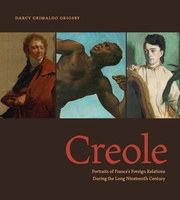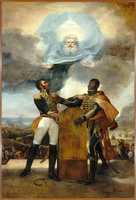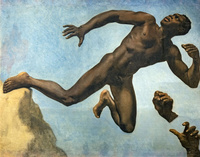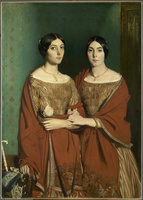Creole: Portraits of France’s Foreign Relations during the Long Nineteenth Century by Darcy Grimaldo Grigsby
Reviewed by Isabelle MattarIsabelle Mattar
Independent scholar
Email the author: Isabellegmattar[at]gmail.com
Citation: Isabelle Mattar, book review of Creole: Portraits of France’s Foreign Relations during the Long Nineteenth Century by Darcy Grimaldo Grigsby, Nineteenth-Century Art Worldwide 23, no. 1 (Spring 2024), https://doi.org/10.29411/ncaw.2024.23.1.11.
This work is licensed under a Creative Commons Attribution-NonCommercial 4.0 International License  unless otherwise noted.
unless otherwise noted.
Your browser will either open the file, download it to a folder, or display a dialog with options.

Darcy Grimaldo Grigsby,
Creole: Portraits of France’s Foreign Relations during the Long Nineteenth Century.
University Park: Penn State University Press, 2022.
368 pp.; 120 color and 84 b&w illus.; bibliography; notes; index.
$99.95 (hardcover)
ISBN: 978–0–271–09154–9
Creole stands as a pioneering work: it is the first book dedicated to the lived experience and representation of Creole individuals in the nineteenth-century French empire. The research compiled by Darcy Grimaldo Grigsby spans two decades of scholarly investigation and transcends the limits seemingly imposed by the scarcity of sources. (Not only are images of or by Creoles scarce, but Creole identity is itself often lost or difficult to demonstrate.) Grigsby’s sustained effort to identify and locate relevant sources and work renders this book an indispensable contribution to art historical scholarship, particularly coveted by those aspiring to decenter prevailing white European narratives. Moreover, rather than offering a narrative focused solely on oppression and colonization, Grigsby introduces a perspective that reveals instances of resistance, self-representation, and the intentional articulation of ambiguous identities by individuals. The scholarly impact of this work will be substantial, as it delineates and characterizes the intricacies of Creole individuals and their representations—a hitherto neglected subject in the realm of art history.
The paradox at the center of the book, as noted in her introduction, is that “the very capaciousness and inclusivity, or should we say lack of precision, of the term Creole engendered a perpetual searching on the part of Creole and French persons for visual signs of racial difference as well as perpetual denial of these signs, a pretense to blindness about the utter intermingling of races in Creole society” (6). Others have noted this paradox, but it has never been examined in art historical terms as closely as it is here.[1]
Creole, here, is not a racial category, although it incorporates racial difference. The term Creole is more capacious than Black or non-white or people of color. It is a transhistorical and transgeographical concept, not legally defined though at times legally discriminating, and Grigsby contributes to shaping its cultural and social application within a specific timeframe and geography. The fluidity of the term allows her to explore its racial determinants, but also to investigate how Creole both inflects and is affected by gender, class, reputation, and family.
Grigsby adheres to the French usage of Creole, signifying anyone born in the colonies, irrespective of their ancestral lineage, be it European, African, or a blend of both. Grigsby acknowledges the drawbacks of this terminology, particularly its potential to legitimize inadvertently artificial constructions. Rather than producing a linear history or a grand narrative of the term, which would be oxymoronic given the term’s paradoxes and contradictions that are so vividly exposed by Grigsby, the different chapters of the book, akin to case studies, demonstrate its capaciousness.
Grigsby clearly warns the reader that the book does not focus on Black individuals but on mixed-race persons, distinguishing it from existing studies such as The Image of the Black in Western Art or Denise Murrell’s Posing Modernity.[2] Creole builds, sometimes in straightforward ways, on Grigsby’s ample and generative previous scholarship. Throughout, she sprinkles autobiographical references, acknowledging the personal resonance of much of her material. Autobiographical reflections emerge especially in relation to questions about lineage, and in particular familial and social networks connecting Creole men. Grigsby places significant emphasis on how individuals define themselves in relation to others and delves into what art historical analysis can unveil about these intricate connections. Notably, chapters are often linked through anecdotal connections between the figures discussed, as opposed to conceptual similarities or shifts.

The book offers fresh interpretations of canonical works by major artists—e.g., Manet’s (1832–83) Olympia (1863; Musée d’Orsay, Paris). Other works, such as Guillaume Lethière’s (1760–1832) Oath of the Ancestors (fig. 1) or the many images of the self-proclaimed emperor of Haiti, Faustin Soulouque (1782–1867), ought to be better known. One of the many accomplishments of the book is its capacity to unveil a plethora of images that have hitherto remained obscure or been entirely consigned to oblivion. Grigsby’s analysis illuminates not only the images, but also, in numerous instances, the experiences of Creole subjects represented in them, as seen in the examination of the lives of Alexandre Dumas père (1802–70) or Théodore Chassériau (1819–56).
The subjects of the various chapters are disparately situated in the French empire, its former colonies, the Second Mexican Empire, and the metropole. This requires Grigsby to devote sections of many chapters to establishing geopolitical and historical contexts. Understanding Lethière’s provocative yet complacent Oath of the Ancestors depends on knowledge of its early nineteenth-century Franco-Haitian setting, Chassériau’s mysterious mid-century self-portraits relate to a different colonial history, and a new interpretation of Manet’s variations on the Execution of Maximilian (1867–69) relies on a history of French and Mexican politics in the second half of the century. And yet, these diverse subjects were indeed united by the stunningly flexible but often denigrating term Creole. By placing Creole at the center of her art history, Grigsby is able to lay bare the contradictions of France’s obsession with racial and colonial identity. She forthrightly exposes the French hypocrisy on race, both historically and in the present context, whether addressing the reinstatement of slavery in 1802 and its final abolition in 1848, or highlighting the remarkably delayed elimination of the expression “nègre” for a ghostwriter in 2017. Indeed, Grigsby seamlessly moves between the nineteenth century and the present day when pertinent. This serves as a reminder to the reader that certain artworks discussed in the book have continued to endure physical or scholarly neglect, and that the racial issues addressed in the nineteenth century persist in the present, albeit with important variations in the United States and France.
The book commences with three anecdotes about Creole subjects that delineate its themes and implications: Thomas Eakins (1844–1916) writing about a mixed-race fellow student, Edmond de Goncourt’s (1822–96) description of two Caribbean women working for Félix Nadar (1820–1910), and an awkward portrait by Manet of Jeanne Duval (1820–62). All three accounts demonstrate the ways in which Creole subjects were dissolved into an array of disparaging signifiers. For Grigsby, they also serve as cautionary tales: the people described by these anecdotes were/are not simply signs; we must remember the violence exercised on their bodies and do our best to recover the individuals behind the signs.
The notion that individuals in images are more than mere signs is consistently upheld throughout, exemplified in Grigsby’s portrayal of Joseph, a Black model from Saint-Domingue, in chapter 3. The comprehensive depiction of Joseph extends beyond his role as a model, encompassing various facets of his identity. As she reminds us, one of Joseph’s notable distinctions lies in his privileged access to the genesis, progression, and completion of Géricault’s Raft of the Medusa (1818–19; Musée du Louvre, Paris). Additionally, in Chassériau’s studies, Joseph enacts “the permanent subjugation of the slave” (100), embodying the Black man’s naked, enslaved physique while retaining the agency to disengage from the depicted scenario and walk away. The great majority of artworks examined are portraits, as the first word of the subtitle announces, but Grigsby delivers her own portraits, in the biographical sense, of the figures studied. We get to know individuals’ careers, the skeletons in their families’ closets, their insecurities and ambitions, their rivals, and their lovers.
Two Josephines constitute the subject of the first chapter: Joséphine de Beauharnais (1763–1814) and Josephine Baker (1906–75). They encapsulate much of the book’s argument: Beauharnais manipulated signs of her creolité but also experienced racism, and Baker’s role in the movie ZouZou (1934) subjects her to colonial fantasies, notwithstanding the career she carved out for herself. The chapter demonstrates the transhistorical, contradictory, and capacious nature of Creoles. It is a conceptually important chapter yet also departs from the suggestion in the introduction that the book is about men. One might even question whether Josephine Baker was in fact Creole.
Joséphine de Beauharnais, France’s most famous Creole according to Grigsby, seemed like a natural place to start. Grigsby amends an argument she proposed twenty-five years ago according to which Joséphine, with her white Grecian fashion, was upstaging the antique canon in an attempt to shift attention away from men’s classicizing art.[3] As Joséphine and other colonial-born women in her circle were associated with a supposed Creole lasciviousness, Grigsby now posits that they used sartorial choices (transparent muslin gowns) to signify sexual availability. Their elite status allowed them to manipulate in unexpected ways visual signs that were created to oppress. The second part of the chapter, on Josephine Baker’s role as ZouZou in the eponymous film, explores the filiations of different races. In the movie, the father adopts two young orphans, ZouZou, a black girl, and Jean, a white (French) boy. The paternal figure is there to ensure that neither incest nor miscegenation occurs. The movie conforms to French ideals of assimilation but also asks “whether intimacy between the un-like safeguards the discreteness of races or compromises it” (27).
Chapter 2 delves into Guillaume Lethière’s strange yet remarkable Oath of the Ancestors, which depicts the alliance between mulatto officer Alexandre Pétion (1770–1818) and the formerly enslaved Black General Jean-Jacques Dessalines (1758–1806) in 1802, during the revolution in Saint-Domingue (modern-day Haiti). Grigsby’s contextualization of the painting is bifocal: it references the moment in 1802 when people of color, the island’s most decisive constituency, finally joined forces with Black rebels and comments on the island’s reunification, which was occurring at the time Lethière painted the picture in 1822. She also explores Lethière’s personal history, travels, and coming to terms with his Creole identity. Finally, she draws attention to the white patriarchal godhead and concludes that his presence is unspoken, implying that the revolution remained incomplete without the “recognition of a white father” (54). Grigsby reflects on the painting’s timeline and journey back to Haiti, but also extrapolates on the personal meaning it carried for the artist. Lethière used the canvas to solidify his personal history by signing with his full name, earned through legal recognition, and also inscribing his birthplace, his terre natale of Guadeloupe.

The following chapter delves into the secretive commission for “a portrait from a model” (68) given by Jean-Auguste-Dominique Ingres (1780–1867) to Théodore Chassériau (fig. 2). Grigsby highlights the colonial power dynamics involving a white man exerting influence over a Black man through a Creole intermediary. Ingres specifically asked Chassériau to paint a study of a “nègre” that could serve as a model for a devil in another, never-realized picture, Christ Chasing the Devil from the Mountain. Ingres sought a realistic representation rather than a fanciful one.
Chassériau temporarily set aside the commission to focus on his career, taking seventeen months to complete and deliver the study. Crucially, Grigsby situates Chassériau’s life experiences and family history within the broader context of literary constructions of Creole identity. This contextualization underscores the pervasive influence of Creole narratives in literature, which often feature recurring themes. Chassériau was labeled as “ugly” by contemporaries, a characterization perpetuated by modern curators, and Grigsby challenges the arbitrary nature of such judgements. Grigsby discerns resemblances between Chassériau’s face and that of figures in his early history paintings and posits that their darkened, shaded faces may refer to Blackness. She dispels the notion that the posthumous engraved portrait could serve as an indication of skin color. Her analysis delves into how Chassériau’s own appearance was, both then and now, subjected to racial discrimination. Finally, Grigsby reflects on the challenges of depicting someone in the midst of falling in a painting, offering valuable insights into intricate, if not torturous, studio practices.

In chapter 4, the question of color, encompassing both skin tone and paint pigment, becomes a fertile ground for Grigsby to highlight the “pretense to blindness about the utter intermingling of races in Creole society” (114). The chapter explores at length the French fascination with the skin complexion of Creoles, exploring the contradictions arising from the conflict between the indeterminacy of the category “Creole” and the desire for a codified and unambiguous racial identity. The chapter revisits Grigsby’s previous scholarship on Delacroix’s portraits of a mixed-race woman known as Aspasie or Aline la Mûlatresse, whose precise identity remains unknown. Despite Grigsby’s eloquent description of her painted flesh, the sitter remains an anonymous symbol of the seductive exoticism attributed to women of mixed race. The discussion of white Creole women brings to light the complexities of taxonomic methods of differentiation, where the term “pale” could signify the complexion of a white Creole. However, the qualifier “pale” could also be used to disparage the fair-skinned Creole whose cheeks would not naturally blush and would have to pinch themselves to display with rosy shades. The chapter concludes with a meticulous analysis of Chassériau’s The Two Sisters or Portrait of Mesdemoiselles C. (fig. 3) that reveals the profound influence of Creole concerns in this haunting portrait. Drawing on insights from the previous chapter, the interpretation of The Two Sisters emphasizes subtle variations in their skin tone as triggers for perpetual markers of distinction between Creole and non-Creole individuals. Grigsby addresses critics’ convictions that the two sisters were infertile and adds complexity to their tender union.
The fifth chapter focuses on print media. Grigsby contends that caricature, rather than painting, served as the primary medium through which French artists explored the evolving status of Black individuals within their broadened political landscape. The abolition of slavery in 1848, she argues, solidified the portrayal of racial difference as a binary opposition, where “blackness signified slavery, whiteness signified freedom” (144). To substantiate her argument, Grigsby examines portraits of Faustin Soulouque, the emperor of Haiti, focusing on the widespread presence of his image in caricatures after 1848 and the meticulous attention given to his specific features by the makers. Both caricatures and formal portraits are considered in her analysis. His likeness was occasionally exploited to represent Napoleon III (1808–73) when press censorship was in effect. In one instance, Napoleon III is portrayed wearing Soulouque’s mask, but the giveaway lies in his white hands. Grigsby contrasts caricatures with other depictions, highlighting the contemporaneous inclination to believe in the presumed objectivity of racist caricatures. She underscores the significance of works like Album Imperial d’Haiti (1852) because they deviated from caricatured representations. Grigsby observes how Black individuals, in turn, could inadvertently render French costumes comical, transforming them into “pompous, unconvincing, and superficial signs of power” (154). The chapter concludes with an engaging analysis of a print illustrating a scene from Alphonse de Lamartine’s Toussaint Louverture (1850). While actors often wore blackface, Grigsby suggests that the artist ambiguously conveyed the main character’s reflective Black skin rather than mere makeup.
The following chapter revolves around three generations of Dumas men: the Revolutionary general born in Saint-Domingue, his son (the novelist and playwright known as Dumas père), and his grandson (the writer known as Dumas fils). Grigsby initially directs our focus to the men’s last name. The General Dumas (1762–1806) adopted his slave mother’s surname upon arrival in Paris, rejecting his aristocratic moniker Davy de la Pailleterie. The process, she notes, inadvertently led to the effacement of his Black mother. While originally intended as a tribute, the name eventually came to symbolize the heroism and feats of the family’s male members.
Focusing on caricatures of Dumas père, the rest of the chapter builds upon the previous one to ask if “race is constructed or deconstructed by caricatures of racially marked persons?” (179). Grigsby recovers Dumas’s self-descriptions, with a specific focus on mentions of his complexion. In his own writings, his appearance and skin color vary with age but also his travels. When others depict him, they either downplay or exaggerate his racial difference. Dumas, Grigsby contends, had to “negotiate incoherent and shifting assumptions about his difference” (173).
Nadar’s caricatures of Dumas père and fils (1824–95), for instance, are a silent comment on how the choice of brown paper exempted the caricaturist from depicting complexion. Grigsby proposes that caricatures like these recontextualized the father and son’s racial difference as “only one kind of nonconformity” (186), thereby rendering race only one of many possible differences. The chapter ends with a seemingly frivolous scandal: Dumas went to trial to prevent the sale of pictures featuring him with the actress Adah Isaacs Menken (1835–68). Dumas, Grigsby concludes, overwhelmed the public with his presence to signal that he could not be reduced to a fixed signifying typology. By opting not only to refrain from disavowing his racial difference but also to comment on its evolving expressions, he spoke directly to the paradoxes of his Creole identity.
In chapter 7, Grigsby turns to Manet’s Olympia to discuss both female figures: Olympia and her maid, Laure. Laure, for Grigsby, should not be isolated. Instead, we are encouraged to view the painting as a “Creole scene constructed from the paid labor of two working-class models whose relation to each other remained unresolved” (205). Compared to Manet’s earlier portrait of Laure, where his painterly struggle to capture her features and skin color is palpable, her appearance in Olympia is a significant improvement. Grigsby stresses, however, that the Black figure in Olympia conformed to the racist and colonial tropes used to depict Creole and Black women—tropes that critics were more than willing to explore. Manet may have suppressed her sexual availability in favor of her identity as a modern worker and Black Parisian, but this came at the expense of repressing the proximity of this identity to prostitution. Grigsby’s attention to specific passages such as the truncation of Laure’s right wrist or the place where the two models meet both prove her point and demonstrate her skilled attention to painterly details. Finally, Grigsby draws our attention to how the relationship between the two is left unresolved in the painting, just as it was in the lives of actual Parisians.
The focus of the final two chapters shifts away from the French empire and centers on the exploration of Creole within Mexican and US contexts. Chapter 8 contains some of Grigsby’s more caustic comments as part of her endeavor to rectify the interpretation of Manet’s various renditions of the execution of Maximilian (1832–67), the Austrian archduke and onetime emperor of the Second Mexican Empire. She targets the enduring impact of formalist readings of Manet and, more importantly, the blatant failures to properly read the subject matter: contrary to its title, it does not represent the execution of Maximilian. “How is it possible,” she asks, “that art historians have dwelled so long on Manet’s picture without interrogating why General Tomás Mejía always takes the bullet?” (230).
Grigsby clarifies the depicted narrative while addressing misconceptions about the placement of the painting’s three main figures: Tomás Mejía (1820–67), Maximilian, and General Miguel Miramón (1831–67). Failure to read the painting correctly has sometimes led to hallucinations that Mejía has three hands, and no one has commented on the racial dynamics in play. She traces the French invention of a “Latin race,” debunking the notion that it referred to non-French and establishing that it was meant to assimilate the French to the peoples of Central and South America. Additionally, Grigsby demonstrates how the three figures executed in Manet’s painting adhere to the standard tripartite schema sometimes used to represent a simplified, racialized understanding of Mexican society: the archduke standing in for the Spanish-born whites, Miramón for the Criollos (Creoles), and Mejía for the Indio (the indigenous people of Mexico). Manet consistently envisioned different iterations of Mejía’s face but fell short of creating a definitive portrait. Grigsby notes the unprecedented nature of depicting Mejía at the exact moment he was shot, as Manet aimed to capture violence in the present. This led to the unsettling portrayal of a racial other fragmented and shot apart.
In the ninth and final chapter, we embark on a journey to New Orleans aboard a ship with Degas (1834–1917). This chapter pays close attention to Degas’s blind cousin Estelle (1843–1909), evoking a sense of fragility that prompts the reader to empathize with the shared emotional and physical vulnerabilities of both Degas and Estelle. Degas’s interest in Estelle’s encroaching blindness was related, Grigsby argues, to the artist’s anxiety about his own delicate eyesight. Grigsby’s discussion of Degas’s fascination with Estelle, as well as Estelle’s pregnancy and postpartum experience, threatens to overshadow the book’s main theme, but the chapter returns to the post-Civil War context of New Orleans, where Creole was applied “not only to French-speaking whites but also to French-speaking blacks and French-speaking mixed-race persons, who were born there, whether they had been slaves before the Civil War or free” (266). Grigsby relates Degas’s use of value contrasts, backlighting, and silhouettes in his New Orleans works to his attitudes about race, and she observes that Degas maintained the illusion of white racial purity as a visual truth while grappling with his family’s Creole heritage.
Creole attests to Grigsby’s remarkable ability to navigate the extensive and diverse body of work that comprises her subject, wrangling it into focused and revealing case studies while simultaneously preserving the expansiveness and capaciousness inherent in the eponymous term. Noteworthy is her judicious decision to not overwhelm the reader with excessive historical background. While pertinent commentary on political events is provided as needed, most chapters make their point without transforming readers into experts on the various political regimes she discusses. This is a distinctive feature of the work, a departure from the prevalent focus in nineteenth-century French art history, often as preoccupied with revolutionary contexts and political regimes as with the art itself.
This book demonstrates unequivocally that the category of Creole can provide a powerful interpretive device for understanding French art as well as France’s distinctive ways of representing identity. Race remains an important category for Grigsby, but she clearly wants to see her material freshly, without relying on received notions and categories. In a “Note on Terminology” in the last few pages, Grigsby reiterates her decision not to capitalize “Black,” “despite the political reasons to do so here and now” (304). Some may desire a more extensive exploration of this choice. Lastly, although the subtitle characterizes the book’s subject as “France’s Foreign Relations,” it centers on France and North America (i.e. the Caribbean, Mexico, and briefly New Orleans). To some extent, the limited geographical scope comes as a detriment to the diversity of the lived experience of Creole people. People from the East Indies, islands such as Madagascar, Reunion, and Mauritius, and more broadly of Afro-Asian descent were also Creole and contributed to shaping the Creole identity in nineteenth-century France. There is more to learn about France’s Creole world.
Notes
[1] Doris Kadish, “Representing Race in Indiana,” George Sand Studies 11, no. 1–2 (1992): 22: “The conflict apparent in the very meaning of the word ‘créole’—the conflict between explicitly denying and implicitly acknowledging differences of race as fundamental to the identity of the inhabitants of the French colonies—is not, I think, merely a linguistic curiosity, but reflects a fundamental conflict about French thinking about their colonies.”
[2] Hugh Honour, The Image of the Black in Western Art, vol. 4 (Cambridge, MA: Harvard University Press, 1989); Denise Murrell, Posing Modernity: The Black Model from Manet and Matisse to Today (New Haven: Yale University Press, 2018).
[3] Darcy Grimaldo Grigsby, “Nudity à La Grecque in 1799,” The Art Bulletin 80, no. 2 (1998): 311–35, https://doi.org/10.2307/3051235.